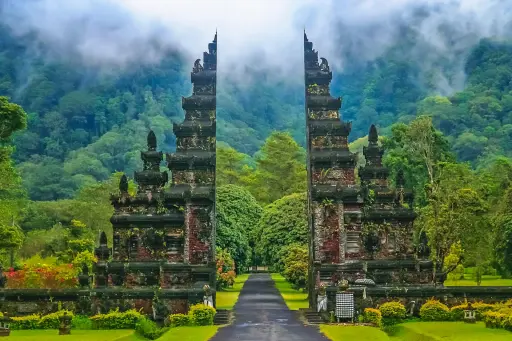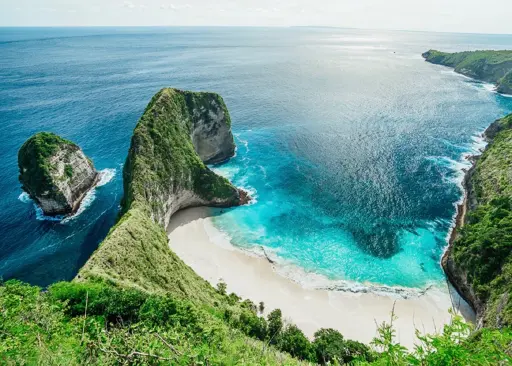Bali is known as the “Island of a Thousand Temples” (Pulau Seribu Pura), and these sacred structures are the beating heart of the island’s rich spiritual life. With over 20,000 temples scattered across the island, each temple serves a specific purpose in Balinese Hinduism, which beautifully blends traditional Hindu practices with indigenous Balinese beliefs and Buddhist influences. Understanding these sacred spaces offers visitors a profound glimpse into the soul of Balinese culture and the daily spiritual practices that have shaped this remarkable island for centuries.
Understanding Balinese Hindu Temple Architecture
Before exploring specific temples, it’s essential to understand the unique architectural principles that govern Balinese temple design. Every temple follows the “Tri Mandala” concept, dividing the sacred space into three zones of increasing holiness:
Jaba Pisan (Outer Courtyard): The least sacred area where preparation and community activities occur. This space often contains administrative buildings and areas for temple festivals.
Jaba Tengah (Middle Courtyard): A transitional sacred space featuring ceremonial kitchens, dance pavilions (bale), and gamelan orchestras during festivals.
Jeroan (Inner Courtyard): The most sacred area containing the main shrines (pelinggih) where deities are believed to reside during ceremonies.
The temples are oriented according to the Balinese directional system, with “kaja” (toward the mountains/Mount Agung) representing the sacred direction and “kelod” (toward the sea) representing the profane direction.
Types of Balinese Temples
Balinese Hindu temples, known as “pura,” fall into several distinct categories, each serving specific spiritual and community functions:
Kahyangan Jagat Temples (Directional/State Temples)
These magnificent directional temples serve as spiritual guardians, protecting the entire island from malevolent forces and maintaining cosmic balance. Strategically positioned around Bali’s perimeter and at significant geographical points, there are six main directional temples, though some sources recognize nine:
Pura Luhur Lempuyang: Guards the east, perched high on Mount Lempuyang with breathtaking views of Mount Agung. Known as the “Gateway to Heaven,” this temple complex consists of seven different temples along the mountainside.
Pura Goa Lawah: Protects the southeast, famous for its cave inhabited by thousands of bats. This 11th-century temple is considered one of Bali’s most important spiritual sites.
Pura Luhur Uluwatu: Safeguards the southwest, dramatically positioned on limestone cliffs 70 meters above the Indian Ocean. Built in the 11th century, it’s dedicated to the spirits of the sea.
These temples are considered so sacred that they belong to all Balinese people, regardless of village affiliation, and host some of the island’s most important religious ceremonies.
Desa (Village) Temples
Every traditional Balinese village maintains three essential temples known as the “Kahyangan Tiga” (Three Village Temples), forming the spiritual foundation of community life:
Pura Puseh (Temple of Origin)
Located in the kaja (mountain-ward) direction of the village, this temple is dedicated to Brahma, the creator god. It serves as the spiritual birthplace of the community, where villagers honor their origins and seek blessings for new beginnings. The temple typically features white and gold decorations symbolizing purity and divine light.
Pura Desa (Village Temple)
Positioned in the center of the village, this temple honors Vishnu, the preserver god. It serves as the community’s main gathering place for important ceremonies, village meetings, and collective decision-making. The architecture often includes a large central courtyard suitable for community gatherings.
Pura Dalem (Temple of the Dead)
Located in the kelod (sea-ward) direction, usually near the village cemetery, this temple is dedicated to Shiva in his role as destroyer and transformer. Here, villagers conduct ceremonies for the deceased and seek protection from negative spiritual forces. The temple often features darker decorations and fierce guardian statues.
Pura Kawangan (Ancestral Temples)
These temples honor specific deified ancestors or legendary figures important to particular communities or regions. They often commemorate historical rulers, holy men, or cultural heroes who have achieved spiritual significance after death.
Family Temples (Sanggah/Merajan)
Found within traditional family compounds (rumah adat), these intimate temples allow families to worship their ancestors and maintain spiritual connections across generations. Every Balinese family compound typically includes:
- Sanggah Kemulan: The main family temple honoring deified ancestors
- Taksu: A shrine for the family’s protective spirits
- Panglurah: A temple for purification rituals
Sacred Geometry and Symbolism
Balinese temples incorporate profound symbolic elements that reflect Hindu-Buddhist cosmology and indigenous beliefs:
Padmasana: The lotus throne shrine dedicated to Sang Hyang Widhi Wasa (the supreme god), typically positioned in the northeast corner of the inner courtyard.
Meru: Multi-tiered pagoda-like structures representing Mount Meru, the cosmic mountain. The number of tiers (always odd, from 3 to 11) indicates the temple’s spiritual hierarchy.
Candi Bentar: The distinctive split gate entrance symbolizing the cosmic mountain split in half, representing the duality of existence.
Guardian Statues: Fierce protective deities (dwarapala) flanking entrances, often depicting Balinese interpretations of Hindu gods in warrior form.
Essential Temple Etiquette and Dress Code
Visiting Balinese temples requires respect for local customs and spiritual practices:
Dress Requirements:
- Sarong and sash (selendang) are mandatory - usually available for rent at major temples
- Covered shoulders and modest clothing
- No revealing or tight-fitting attire
- Remove shoes before entering inner courtyards
Behavioral Guidelines:
- Keep your head lower than the priest during ceremonies
- Don’t point feet toward shrines or altars
- Photography may be restricted in certain areas
- Maintain quiet, respectful behavior
- Don’t interrupt ongoing ceremonies
Who Cannot Enter:
- Menstruating women (traditional belief, though not universally enforced)
- People with open wounds
- Those who have recently experienced a death in the family (during mourning period)
Must-Visit Sacred Temples
Pura Besakih (Mother Temple)
Located on the slopes of Mount Agung, Bali’s highest and most sacred volcano, Besakih is the largest and most important temple complex on the island. Known as the “Mother Temple” (Pura Besakih), this magnificent complex comprises 23 separate temples spread across terraced courtyards, dating back more than 1,000 years.
The main temple, Pura Penataran Agung, features a towering 11-tiered meru dedicated to Shiva. The complex serves as the spiritual center for all Balinese Hindus and hosts the island’s most important ceremony, Eka Dasa Rudra, held once every 100 years. The temple’s position on Mount Agung’s slopes provides breathtaking panoramic views across eastern Bali.
Best Time to Visit: Early morning (6-8 AM) for fewer crowds and clearer mountain views
Spiritual Significance: Supreme state temple representing the unity of all Balinese people
Pura Tanah Lot
Perched dramatically on a rock formation surrounded by the sea, Tanah Lot is perhaps Bali’s most iconic and photographed temple. Built in the 16th century by the revered priest Dang Hyang Nirartha, it’s dedicated to the sea gods and serves as one of the seven sea temples (Pura Segara) forming a chain along Bali’s southwest coast.
During high tide, the temple appears to float on the ocean, creating a mystical atmosphere that has inspired countless visitors. The temple is famous for its resident sea snakes, considered guardians of the temple, and the holy water spring at its base, accessible only during low tide.
Best Time to Visit: Sunset for spectacular photography and spiritual atmosphere
Spiritual Significance: Protection from evil sea spirits and blessings for fishermen
Pura Luhur Uluwatu
Dramatically positioned on limestone cliffs 70 meters above the Indian Ocean, Uluwatu Temple is one of Bali’s six key directional temples and a masterpiece of ancient architecture. Built in the 11th century and expanded by Dang Hyang Nirartha in the 16th century, the temple is dedicated to the spirits of the sea and serves as a guardian against evil forces from the south.
The temple is famous for its mischievous monkey population, considered guardians of the temple, and its spectacular sunset kecak fire dance performances held nightly in an adjacent amphitheater carved into the cliff face.
Best Time to Visit: Late afternoon for sunset views and cultural performances
Spiritual Significance: Directional guardian temple protecting Bali from southern evil spirits
Pura Tirta Empul
Located in the village of Manukaya near Tampaksiring, Tirta Empul is renowned for its holy water springs that have been used for purification rituals for over 1,000 years. The temple was built around a natural spring that locals believe was created by the god Indra to revive his soldiers poisoned by the demon king Mayadenawa.
The temple features 30 water spouts, each with specific purification purposes. Balinese Hindus come here for “melukat” (purification ceremonies), believing the sacred water can cleanse negative karma and provide spiritual healing. The temple complex includes beautiful pools where visitors can participate in purification rituals under the guidance of temple priests.
Best Time to Visit: Early morning (6-8 AM) for authentic purification ceremonies
Spiritual Significance: Primary purification temple for cleansing negative karma
Pura Lempuyang Luhur
Known as the “Gateway to Heaven,” this temple complex consists of seven different temples positioned along the slopes of Mount Lempuyang in eastern Bali. The main temple, Pura Lempuyang Luhur, sits at 1,175 meters above sea level and offers spectacular views of Mount Agung framed through its iconic split gates.
The journey to reach the highest temple involves climbing 1,700 steps through seven different temple levels, each representing a stage of spiritual purification. The temple is considered one of the oldest and most revered in Bali, predating many other major temples by centuries.
Best Time to Visit: Early morning (5-7 AM) for clear Mount Agung views and cooler temperatures
Spiritual Significance: Eastern directional guardian temple and spiritual purification journey
Pura Goa Lawah (Bat Cave Temple)
Built around a natural cave inhabited by thousands of bats, this 11th-century temple serves as one of Bali’s six directional temples, protecting the southeast. The cave is believed to lead to Pura Besakih through an underground tunnel, though this has never been proven.
The temple is particularly significant for Balinese Hindus as a place where important purification ceremonies are conducted before major rituals at other temples. The constant sound of thousands of bats creates an otherworldly atmosphere that adds to the temple’s mystical appeal.
Best Time to Visit: Late afternoon when bats are most active
Spiritual Significance: Directional guardian temple and purification site for major ceremonies
Pura Taman Ayun
Located in Mengwi, this royal temple was built in 1634 by the Raja of Mengwi and represents one of Bali’s most beautiful temple complexes. Surrounded by a wide moat and featuring magnificent multi-tiered meru towers, the temple exemplifies classical Balinese architecture and garden design.
The temple served as the main royal temple for the Mengwi kingdom and features 27 different shrines representing various deities and deified ancestors. The name “Taman Ayun” means “beautiful garden,” reflecting the temple’s stunning landscape design that combines spiritual architecture with natural beauty.
Best Time to Visit: Mid-morning for photography and peaceful atmosphere
Spiritual Significance: Royal ancestral temple representing the power and spirituality of the Mengwi kingdom
Pura Sekumpul
Hidden in the mountains of northern Bali near Singaraja, Sekumpul temple is considered one of the island’s most sacred but least visited major temples. The temple complex consists of multiple shrines built around natural springs and waterfalls, creating a mystical atmosphere where nature and spirituality merge seamlessly.
The temple is particularly significant for its role in water blessing ceremonies and its connection to the Sekumpul waterfalls, considered among Bali’s most beautiful. The relative isolation has preserved its authentic spiritual atmosphere, making it a powerful place for meditation and spiritual reflection.
Best Time to Visit: Early morning for mystical atmosphere and fewer tourists
Spiritual Significance: Sacred water temple connected to natural springs and waterfalls
Temple Festivals and Ceremonies
Understanding Balinese temple festivals enhances any temple visit and provides insight into living Hindu-Balinese culture:
Odalan (Temple Anniversary)
Every temple celebrates its consecration anniversary according to the 210-day Balinese Pawukon calendar. These festivals transform temples into vibrant celebrations featuring:
- Elaborate offerings (penjor) decorating village streets
- Traditional gamelan orchestras
- Classical Balinese dances
- Community feasts
- Colorful ceremonial processions
Galungan and Kuningan
These major island-wide festivals occur every 210 days, celebrating the victory of dharma (good) over adharma (evil). Temples throughout Bali hold special ceremonies, and families create beautiful penjor decorations along village streets.
Nyepi Ceremonies
The Balinese New Year involves elaborate purification ceremonies at temples throughout the island, culminating in a day of complete silence and reflection.
Planning Your Temple Journey
Best Times to Visit Temples
Early Morning (6-8 AM): Cooler temperatures, fewer crowds, active ceremonial life
Late Afternoon (4-6 PM): Beautiful lighting for photography, sunset ceremonies
Avoid: Midday heat (11 AM-2 PM) and major tourist rush hours
Transportation Options
Private Driver: Most flexible option for visiting multiple temples
Scooter Rental: Adventurous option for experienced riders
Organized Tours: Convenient for first-time visitors
Public Transport: Limited but available for major temples
Recommended Temple Circuits
East Bali Circuit: Besakih → Lempuyang → Goa Lawah → Tirta Gangga
South Peninsula: Uluwatu → Tanah Lot → Taman Ayun
Central Mountains: Tirta Empul → Gunung Kawi → Sebatu
North Bali Hidden Gems: Sekumpul → Brahma Vihara Arama → Banjar Hot Springs
Cultural Impact and Modern Significance
Balinese temples remain living centers of community life, not merely tourist attractions. They serve multiple functions in modern Balinese society:
Community Centers: Village temples host meetings, cultural events, and social gatherings
Educational Institutions: Children learn traditional arts, music, and religious practices
Cultural Preservation: Temples maintain traditional crafts, architecture, and performance arts
Economic Centers: Temple festivals support local artisans, musicians, and food vendors
Environmental Protection: Temple forests and sacred groves preserve biodiversity
Conclusion
Bali’s temples offer far more than architectural beauty or photographic opportunities—they provide windows into a living spiritual tradition that has evolved over centuries while maintaining its essential character. Whether you’re drawn by spiritual curiosity, cultural interest, or simple wonder at human creativity, these sacred spaces offer profound experiences that connect visitors to the deeper rhythms of Balinese life.
Each temple tells a story not just of religious devotion, but of community identity, artistic achievement, and the ongoing dialogue between tradition and modernity that defines contemporary Bali. By approaching these sacred spaces with respect, curiosity, and openness, visitors can gain not just memories and photographs, but genuine insight into one of the world’s most vibrant spiritual cultures.
Remember that temples are first and foremost places of worship for the Balinese people. Your visit should honor this primary purpose while enriching your own understanding of this remarkable island’s spiritual heritage.



